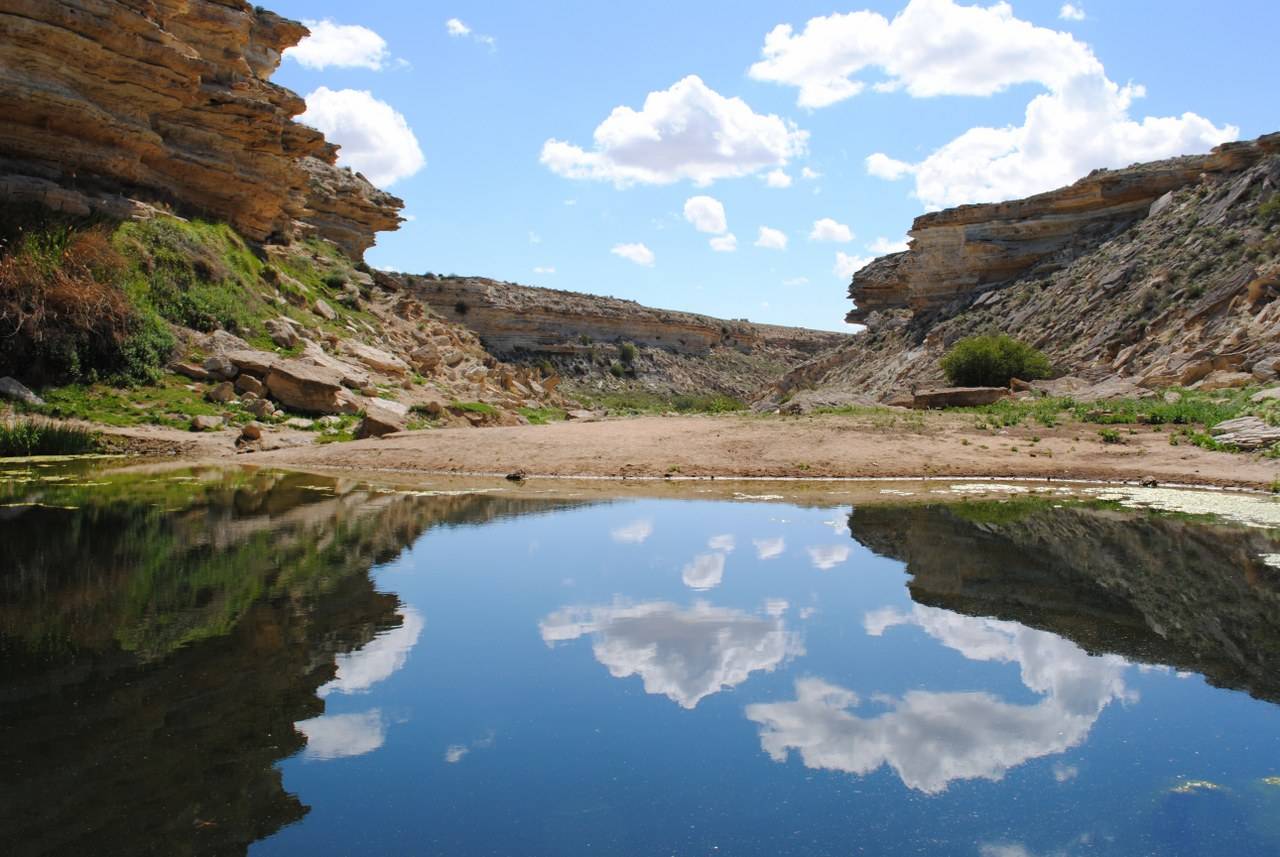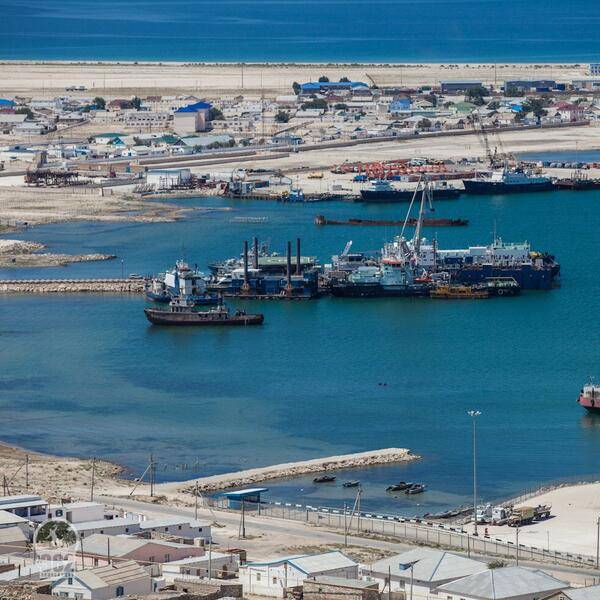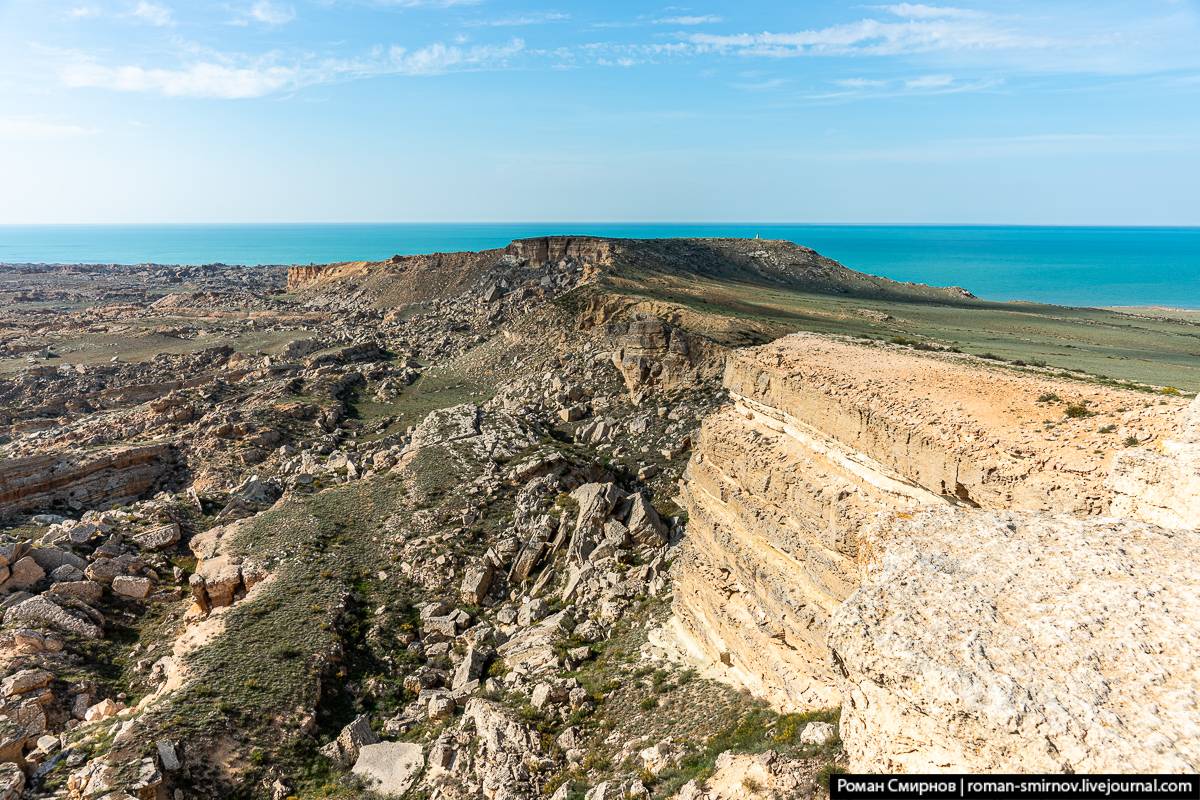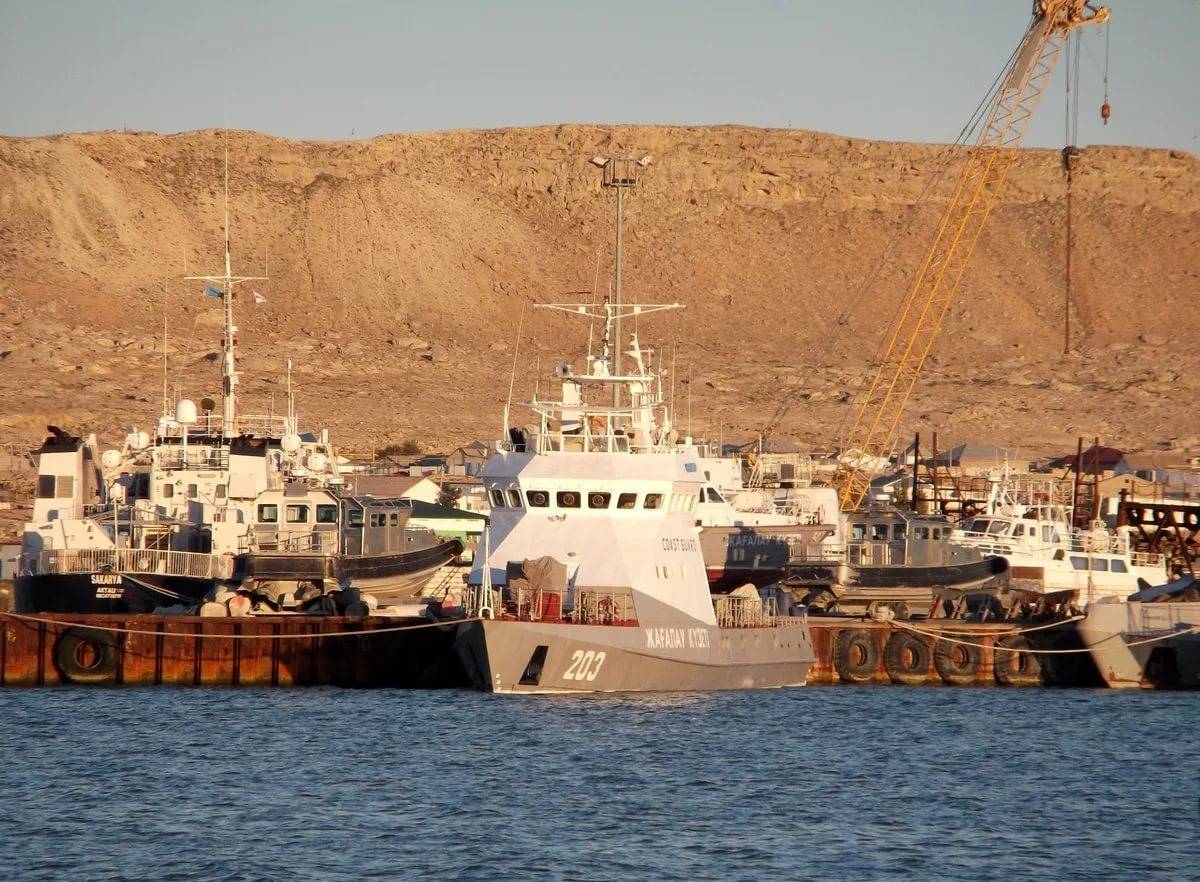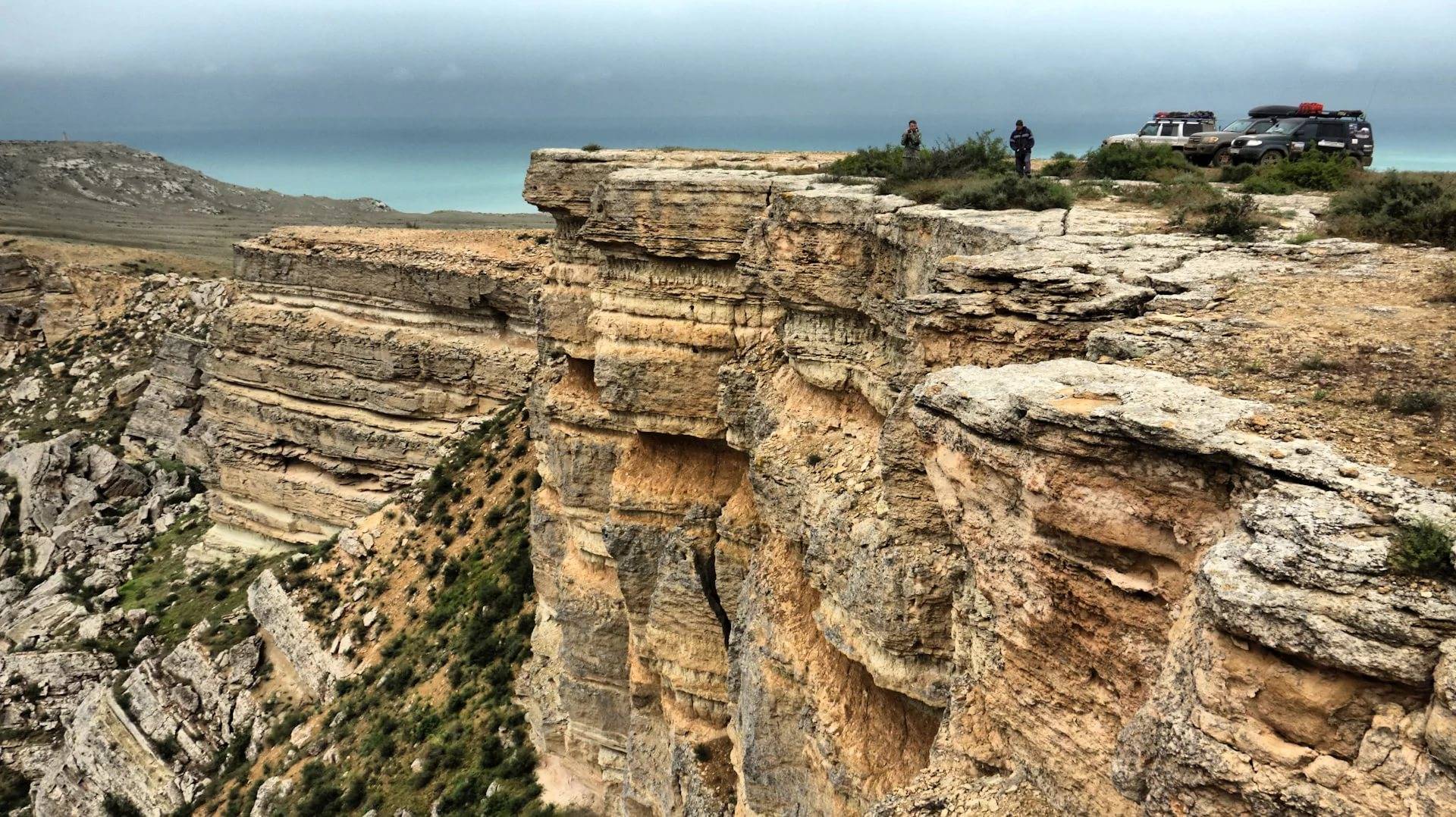Treasure Peninsula
The long and narrow cape Tyub-Karagan is the northern extension of the Mangyshlak peninsula. The cognominal Tyub-Karagan Bay wash this cape From the south. At the very beginning of this picturesque bay, there is the port of Bautino and the small settlement of Atash. For a long time, this bay has been a convenient harbor for ships.
Cape Tyub-Karagan is an incredibly picturesque nature, where you can find all the variety of deserts. Here you can see canyons with a negative slope and unique groves in caves, the mysterious Sharov Valley, Cape Zhygylgan, Sherkala, and the magnificent valley of the Ayrykty Shumanai castles. Lovers of architecture will be interested in visiting the legendary underground mosque Shakpak-ata.

From the coast of the Tyub-Karagan Cape, you can see the Tyulenyi Islands. Unique Caspian seals live there. The environment is an atypical habitat for seals that prefer colder climates. This type of seal is listed in the International Red Book.
Saura is a small area near the coast of the Caspian Sea. Here, in a little canyon, the "Black Pearl" of Mangyshlak is hidden from prying eyes - a small freshwater lake, which was named Karakol. In rainy periods, here you can see a waterfall, unique for these places, which falls from a ten-meter step of a moistureless rocky channel. The channel has been shaped by seasonal flows of water for centuries and is an unforgettable natural landscape. The name of the lake means a black lake in Kazakh. This name is because the lake is quite deep (about five meters), which gives the water a mysterious deep color. The unique conditions made it possible for the relict species of marsh turtle, which lives in freshwaters, to survive here. It will be interesting for tourists to see how the turtles crawl out to bask on the stones with the first warm rays of the sun. Another surprising fact is that sometimes this species of turtles are found on the shores of the Caspian Sea, and they feel great in the saltwater.

In the north-east of the Tyub-Karagan peninsula, you can see a magnificent creation of nature - Zhygylgan (from the Kazakh language it translates as "Fallen Land"). Zhygylgan is an enormous geological landslide that is striking in its scale. It arose as a result of the erosion of a pillow of clay and sand, on top of which there was a huge limestone layer. The plate with an enormous weight easy squeezed the soft rock into the sea, and itself transformed into a colossal failure that excites the mind. Thanks to such a unique phenomenon as Zhygylgan, scientists and tourists had an incredible opportunity to explore and contemplate stone blocks with imprints on their surface of fossilized footprints of large and small saber-toothed mahairod cats, and hoof prints of small three-toed prehistoric horses - hipparions. Scientists say that the average age of these tracks is about ten-fifteen million years. With all its glory, Zhygylgan remains a very spiritual place, far from being explored and full of secrets. According to ancient legends, spirits live in these places.

Shakpak-ata underground mosque. According to ancient legends and folk legends, in the northern part of the Tyub-Karagan peninsula there lived an old man who possessed the gift of healing and healing - Shakpak-ata. This elder lived in a dwelling carved into a large cave in limestone rock. Thanks to his miraculous gift, the people fell in love with the elder and revere him to this day. Hundreds of years have passed, but people still come to his home to heal their bodies and soul. According to legend, the power of the ancient healer helps the suffering and saves the sick from various diseases. According to the results of research by archaeologists, the building of the mosque itself was built in the ninth - tenth centuries. The people gave her a name in honor of the great Sufi and sage Shakpak-ata, who lived here with his disciples. In his last years of life, Shakpak-ata became a recluse and never left his underground home.

Another memorable place on the Tyub-Karagan cape is the famous Ball Valley. Another name under which this area is known is "Torysh." According to an ancient legend, an enormous army of enemies came to the vastness of Mangyshlak. In desperation, the locals turned to the sky, praying for help in the battle. Their pleas were heard. The skies were covered with clouds, a heavy downpour poured from the sky, lightning blazed and thunder roared. At the same moment, all enemy wars froze and turned to stones. Thus, huge bizarre fields of unusual stone formations - spherical nodules - appeared in the vastness of Mangystau. The balls are up to four meters in diameter. Sometimes you can find larger specimens. Concretions form amazing heaps of forms that will not leave anyone indifferent.

Covered with folk legends, Mount Sherkala deservedly became a symbol of Mangystau's nature. If you look at the mountain from a certain angle, then it resembles a giant yurt built by giant nomads. Mount Sherkala is an outlier of impressive size and unusual shapes, which was formed as a result of raising the land from the sea and the formation of the Priratau mountain valleys. One of the many legends about the mountain, tells about the heroes who defended themselves from enemies on Mount Sherkala. The heroes fought like tigers, but the last of them, hiding in the underground passages in the mountain, remained in it to this day. The name of the mountain Sherkala or the city of tigers came from this legend, the embodiment of the courage and honor of warriors-heroes.
Airakty-Shomanay is a natural landmark, known among the local population under this name, a system of small remnant mountains. The Airakty mountains are like castles from old fairy tales with towers and tapers, columns, and fortresses. A panoramic view of the Airakty-Shomanai and Aktau mountains opens up to those who can walk along the path already trodden by horses and go to the observation deck. In rainy spring weather, the area of the valley becomes magical thanks to the scent of a field of Sogdian tulips. Along the sides of Mount Airakty, on blocks of chalk, you can see scratched drawings, called by one of the researchers "Steppe Symphonies."
Предыдущие статьи
Symbol of Strength and Freedom of the Spirit - Otpan Tau Modern historical monument
Духовный комплекс “Отпан тау” - это памятник старины под открытым небом. За…
